A modular approach to integrate nature into the city through a highly spatially and materially efficient structure.


A modular approach to integrate nature into the city through a highly spatially and materially efficient structure.


Grids, shells, and how they, in conjunction with the study of the natural world, can help us develop increasingly complex structural geometry.
This post is the third installment of sort of trilogy, after Shapes, Fractals, Time & the Dimensions they Belong to, and Developing Space-Filling Fractals. While it’s not important to have read either of those posts to follow this one, I do think it adds a certain level of depth and continuity.
Regarding my previous entries, it can be difficult to see how any of this has to do with architecture. In fact I know a few people who think studying fractals is pointless.
Admittedly I often struggle to explain to people what fractals are, let alone how they can influence the way buildings look. However, I believe that this post really sheds light on how these kinds of studies may directly influence and enhance our understanding (and perhaps even the future) of our built environment.
On a separate note, I heard that a member of the architectural academia said “forget biomimicry, it doesn’t work.”
Firstly, I’m pretty sure Frei Otto would be rolling over in his grave.
Secondly, if someone thinks that biomimicry is useless, it’s because they don’t really understand what biomimicry is. And I think the same can be said regarding the study of fractals. They are closely related fields of study, and I wholeheartedly believe they are fertile grounds for architectural marvels to come.
As far as classification goes, shells generally fall under the category of two-dimensional shapes. They are defined by a curved surface, where the material is thin in the direction perpendicular to the surface. However, assigning a dimension to certain shells can be tricky, since it kinda depends on how zoomed in you are.
A strainer is a good example of this – a two-dimensional gridshell. But if you zoom in, it is comprised of a series of woven, one-dimensional wires. And if you zoom in even further, you see that each wire is of course comprised of a certain volume of metal.
This is a property shared with many fractals, where their dimension can appear different depending on the level of magnification. And while there’s an infinite variety of possible shells, they are (for the most part) categorizable.
Analytic geometry is created in relation to Cartesian planes, using mathematical equations and a coordinate systems. Synthetic geometry is essentially free-form geometry (that isn’t defined by coordinates or equations), with the use of a variety of curves called splines. The following shapes were created via Synthetic geometry, where we’re calling our splines ‘u’ and ‘v.’
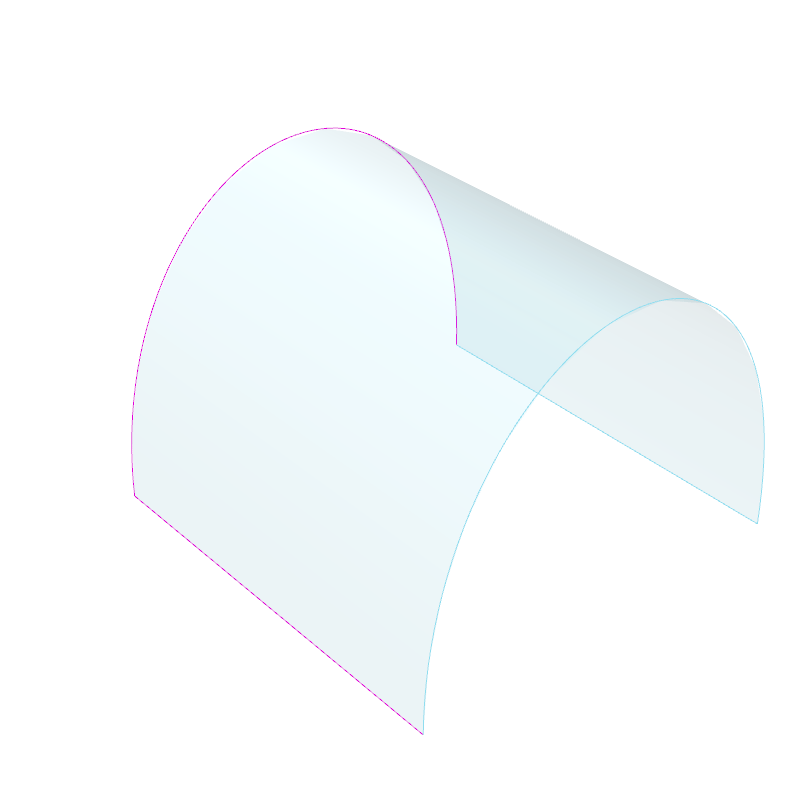
These curves highlight each dimension of the two-dimensional surface. In this case only one of the two ‘curves’ is actually curved, making this shape developable. This means that if, for example, it was made of paper, you could flatten it completely.
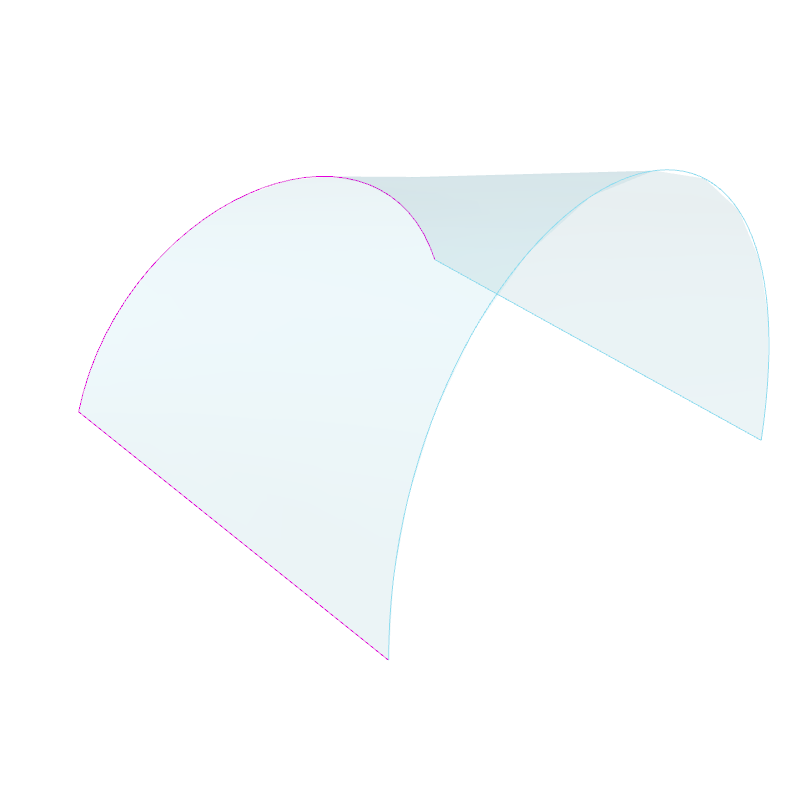
In this case, one of them grows in length, but the other still remains straight. Since one of the dimensions remains straight, it’s still a single curved surface – capable of being flattened without changing the area. Singly curved surfaced may also be referred to as uniclastic or monoclastic.
These can be classified as synclastic or anticlastic, and are non-developable surfaces. If made of paper, you could not flatten them without tearing, folding or crumpling them.
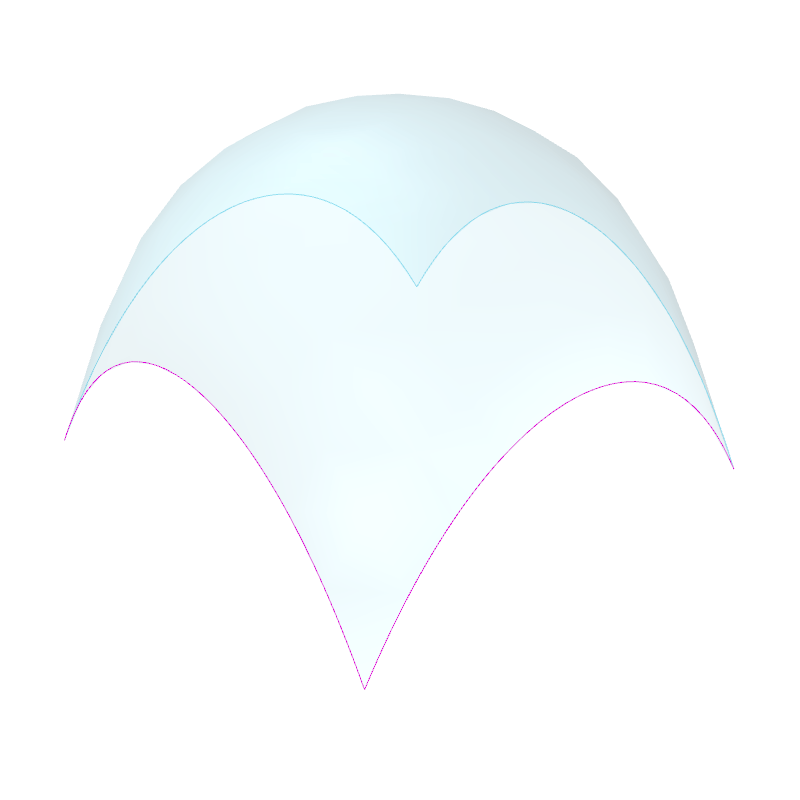
In this case, both curves happen to be identical, but what’s important is that both dimensions are curving in the same direction. In this orientation, the dome is also under compression everywhere.
The surface of the earth is double curved, synclastic – non-developable. “The surface of a sphere cannot be represented on a plane without distortion,” a topic explored by Michael Stevens: https://www.youtube.com/watch?v=2lR7s1Y6Zig
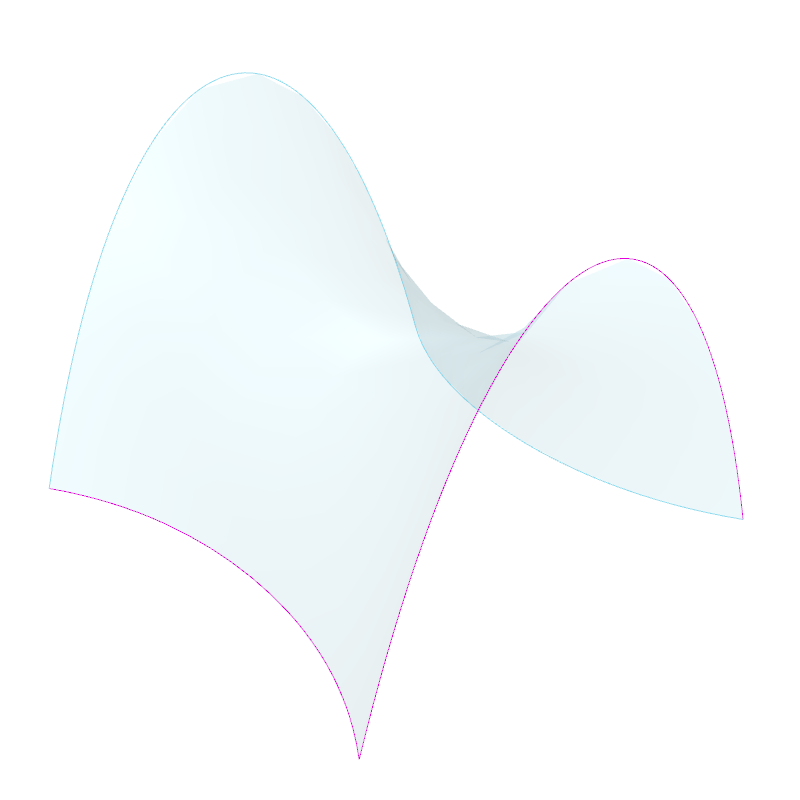
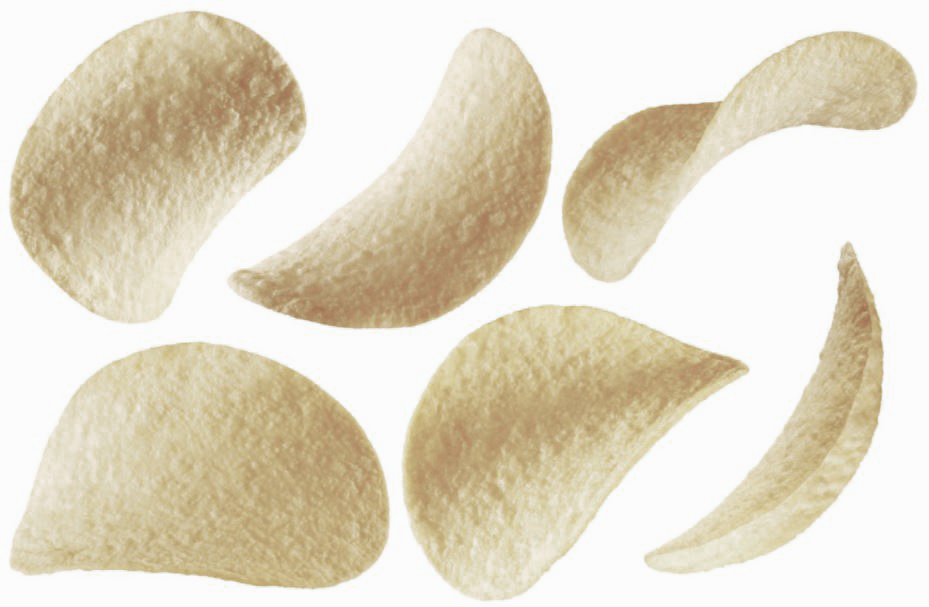
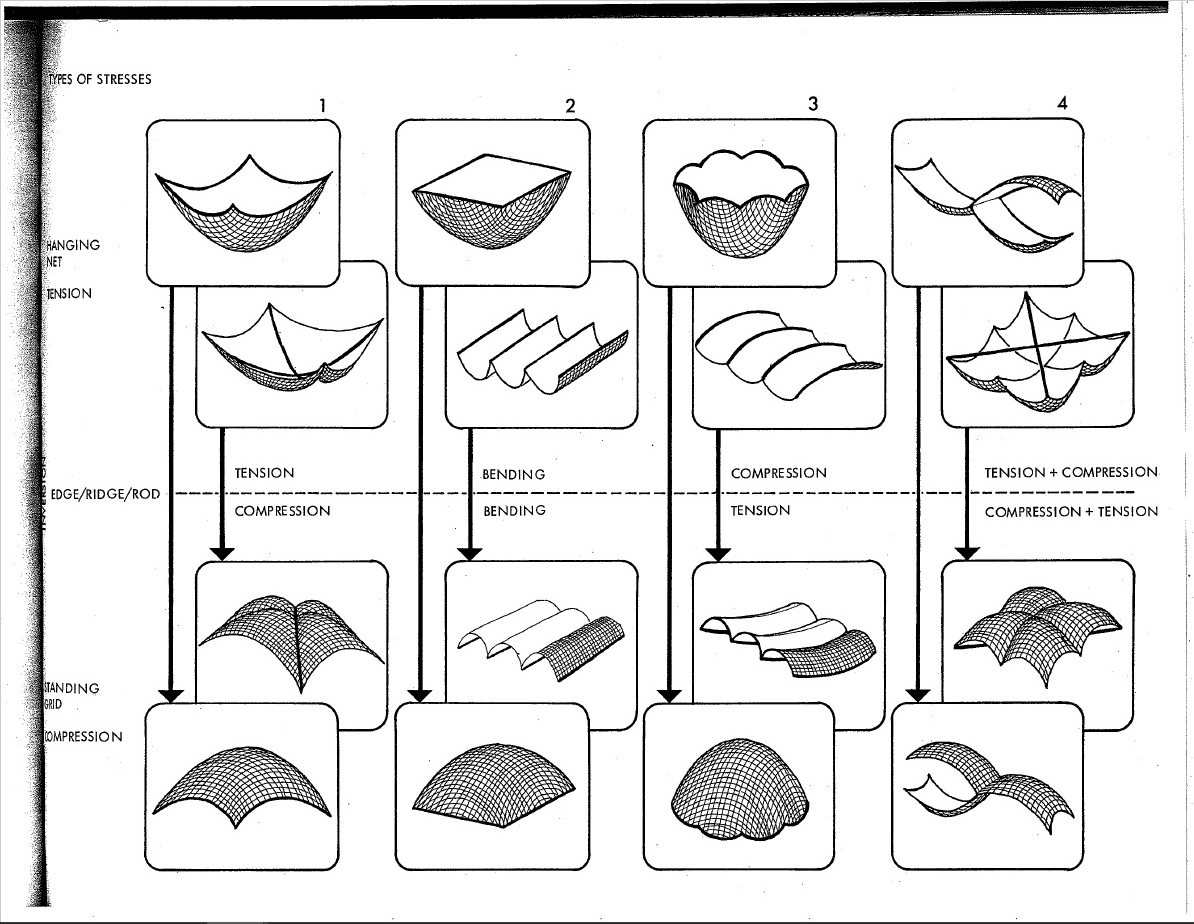
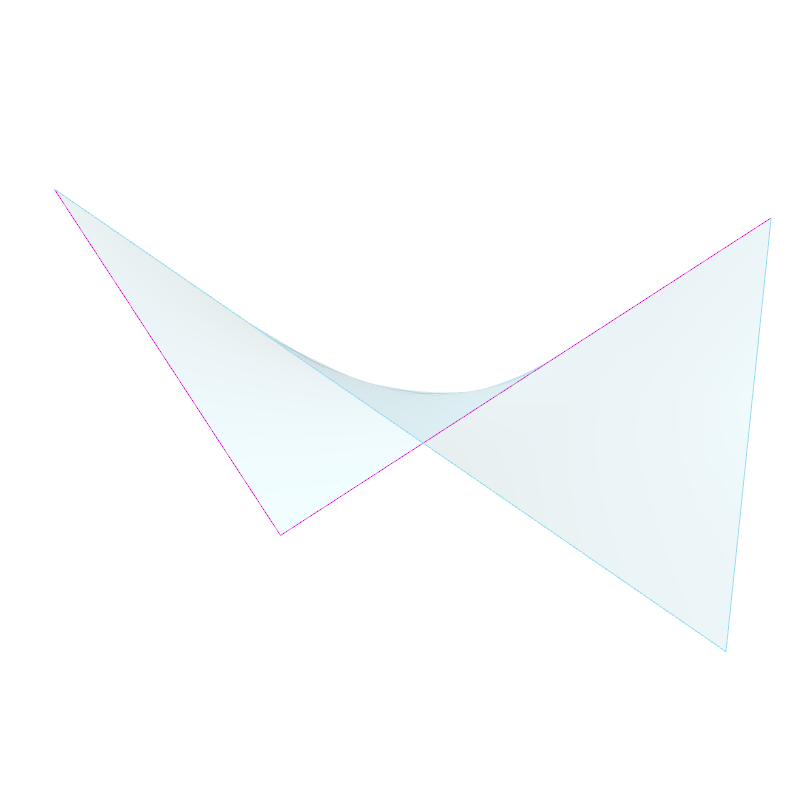
This shape was achieved by sweeping a straight line over a straight path at one end, and another straight path at the other. This will work as long as both rails are not parallel. Although I find this shape perplexing; it’s double curvature that you can create with straight lines, yet non-developable, and I can’t explain it..
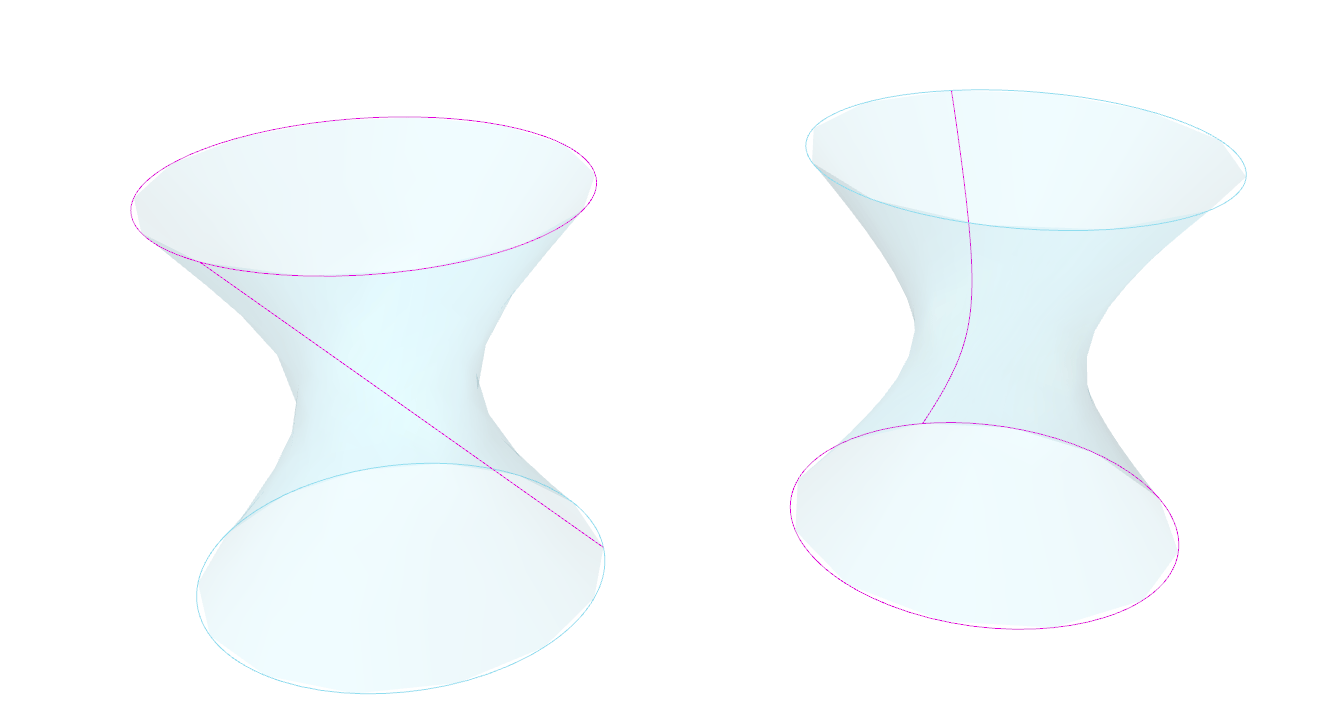
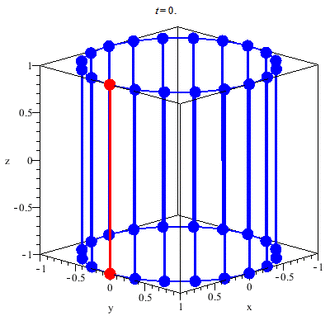
The hyperboloid has been a popular design choice for (especially nuclear cooling) towers. It has excellent tensile and compressive properties, and can be built with straight members. This makes it relatively cheap and easy to fabricate relative to it’s size and performance.
These are singly curved curves, although that does sound confusing. A simple way to understand what geodesic curves are, is to give them a width. As previously explored, we know that curves can inhabit, and fill, two-dimensional space. However, you can’t really observe the twists and turns of a shape that has no thickness.
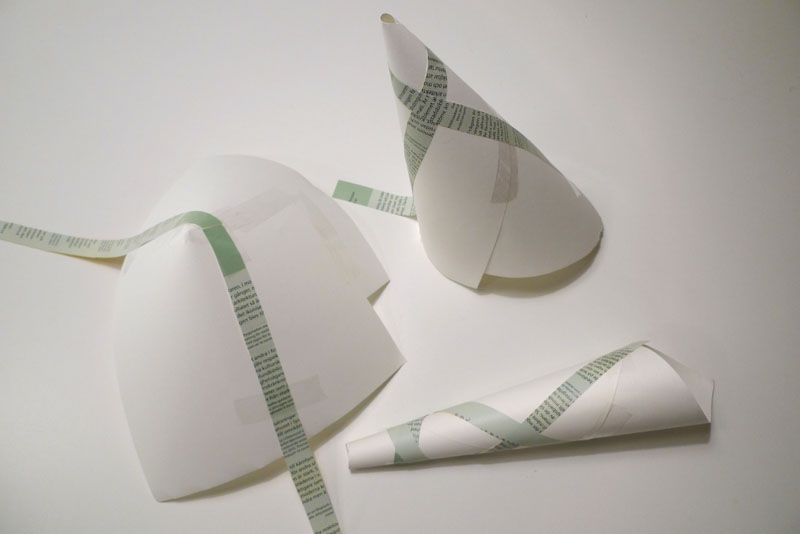
A ribbon is essentially a straight line with thickness, and when used to follow the curvature of a surface (as seen above), the result is a plank line. The term ‘plank line’ can be defined as a line with an given width (like a plank of wood) that passes over a surface and does not curve in the tangential plane, and whose width is always tangential to the surface.
Since one-dimensional curves do have an orientation in digital modeling, geodesic curves can be described as the one-dimensional counterpart to plank lines, and can benefit from the same definition.
The University of Southern California published a paper exploring the topic further: http://papers.cumincad.org/data/works/att/f197.content.pdf
For simplicity, here’s a basic grid set up on a flat plane:
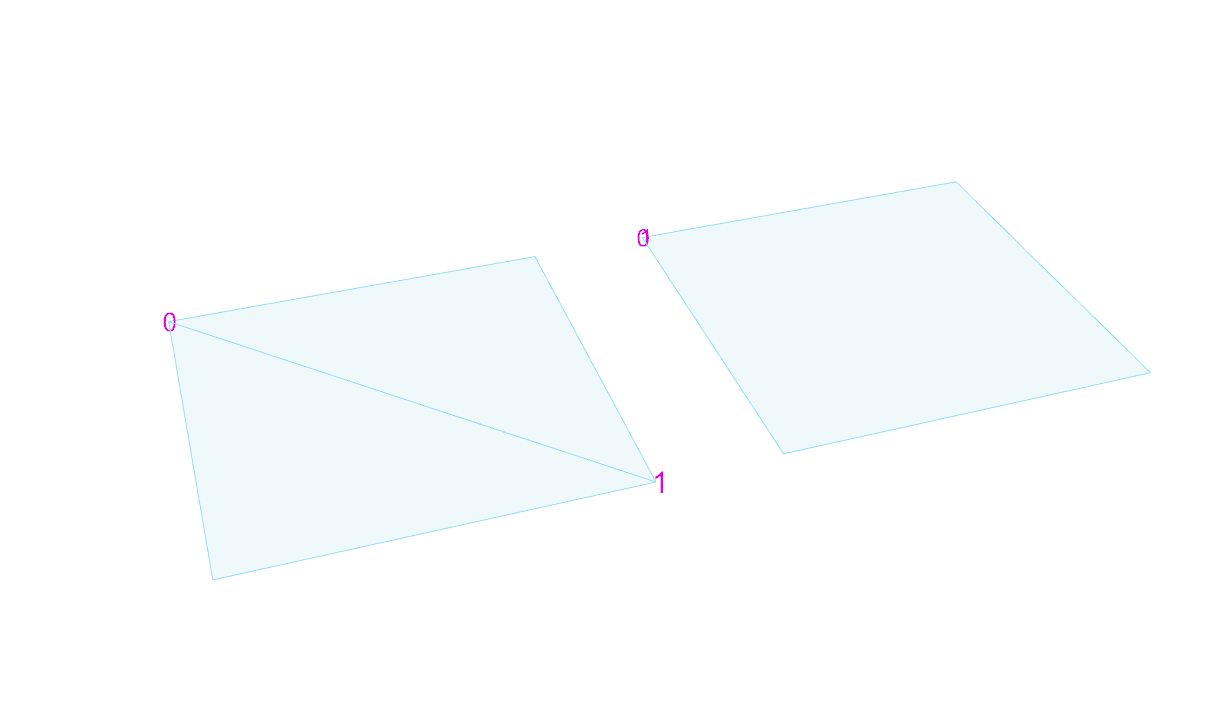
We start by defining two points anywhere along the edge of the surface. Then we find the geodesic curve that joins the pair. Of course it’s trivial in this case, since we’re dealing with a flat surface, but bear with me.
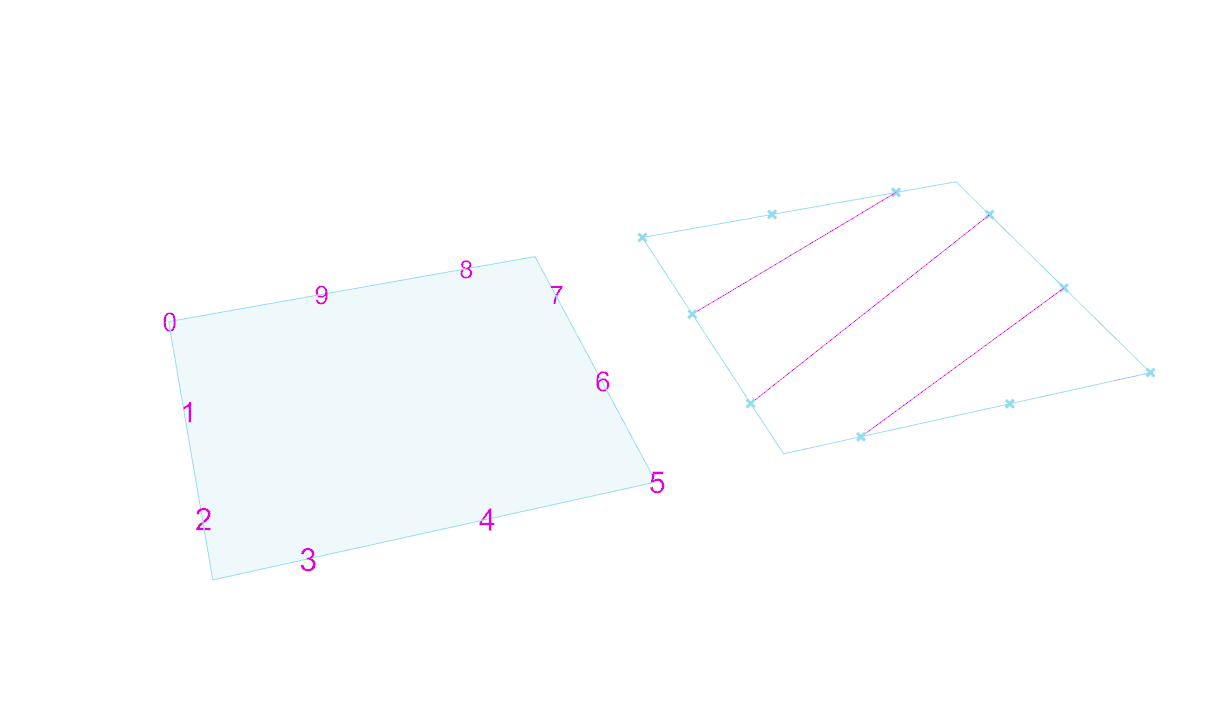
We can keep adding pairs of points along the edge. In this case they’re kept evenly spaced and uncrossing for the sake of a cleaner grid.
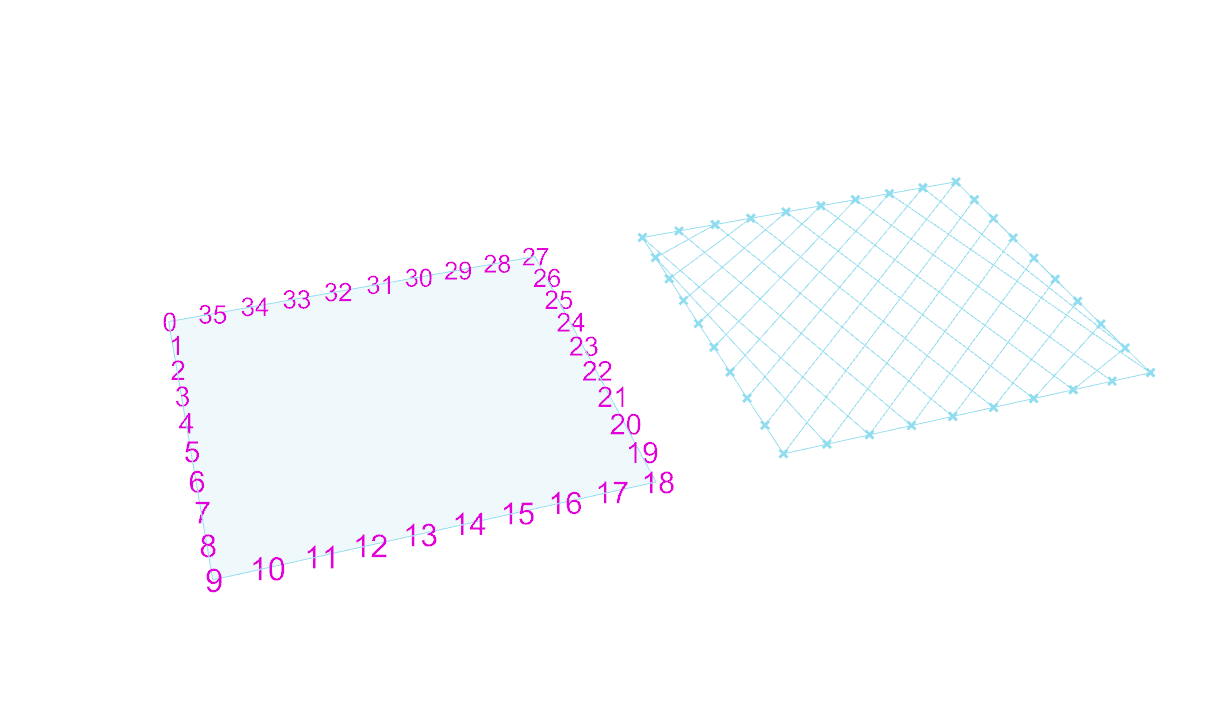
After that, it’s simply a matter of playing with density, as well as adding an additional set of antagonistic curves. For practicality, each set share the same set of base points.
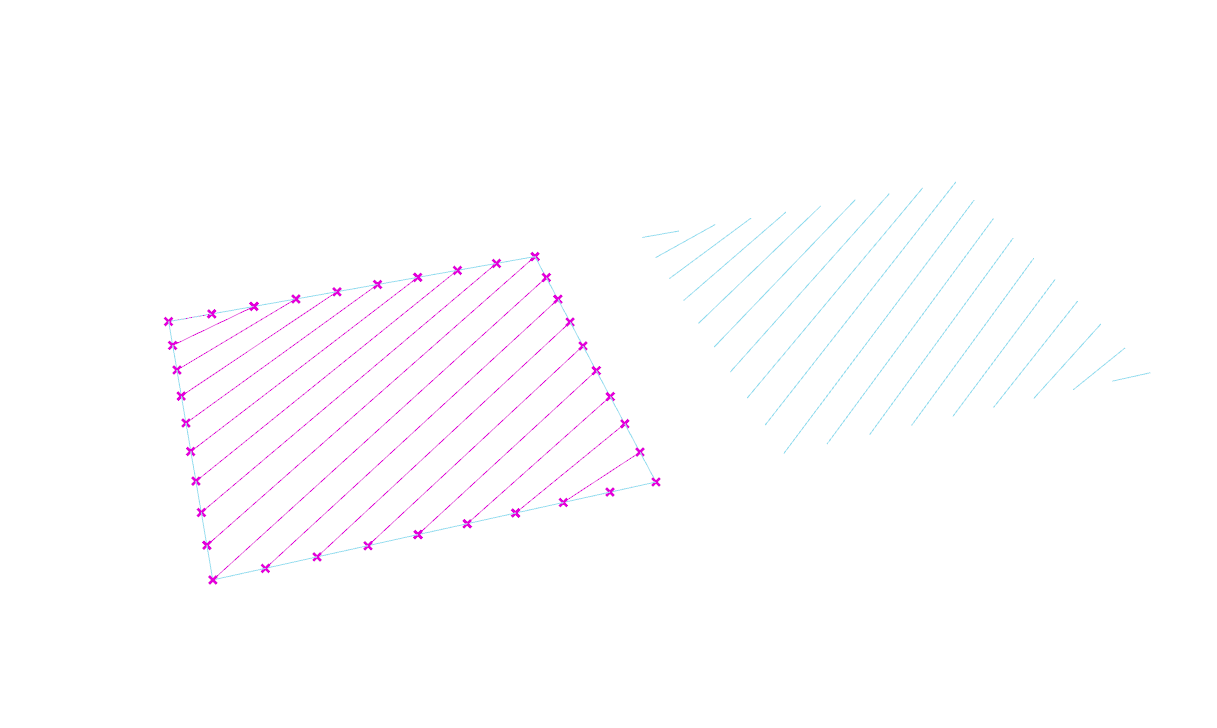
He’s an example of a grid where each set has their own set of anchors. While this does show the flexibility of a grid, I think it’s far more advantageous for them to share the same base points.
The same principle is then applied to a series of surfaces with varied types of curvature.
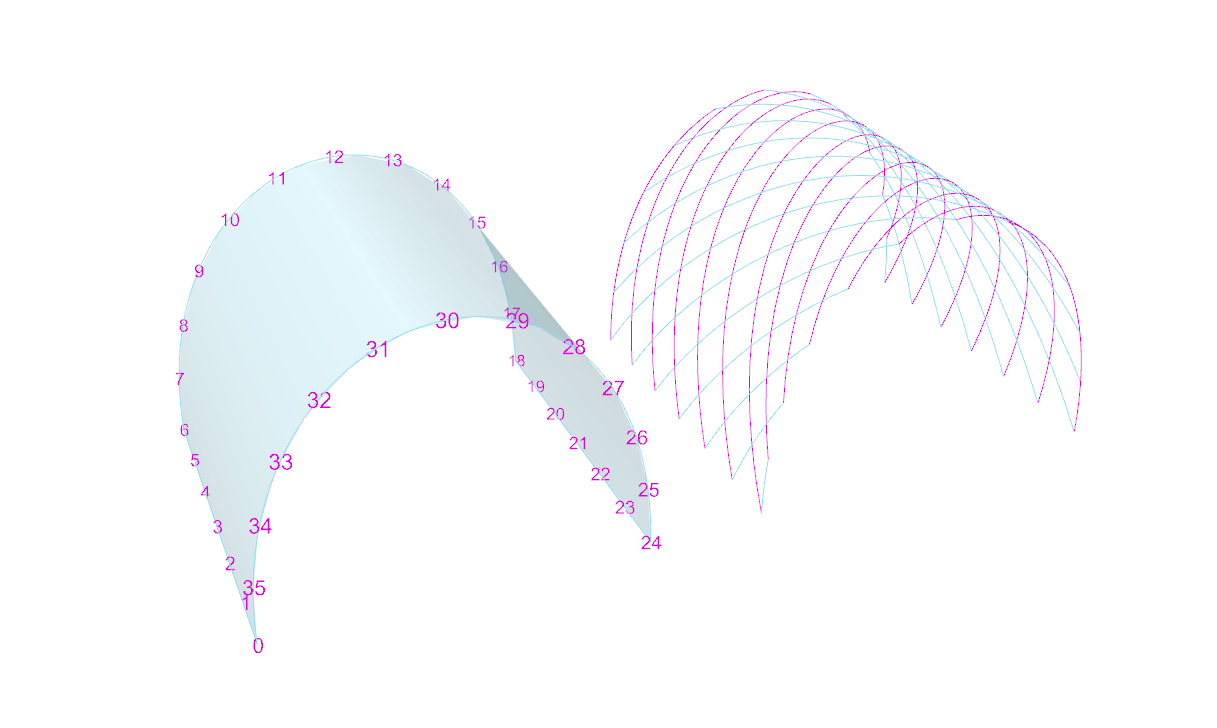
First comes the shell (a barrel vault in this case), then comes the grid. The symmetrical nature of this surface translates to a pretty regular (and also symmetrical) gridshell. The use of geodesic curves means that these gridshells can be fabricated using completely straight material, that only necessitate single curvature.
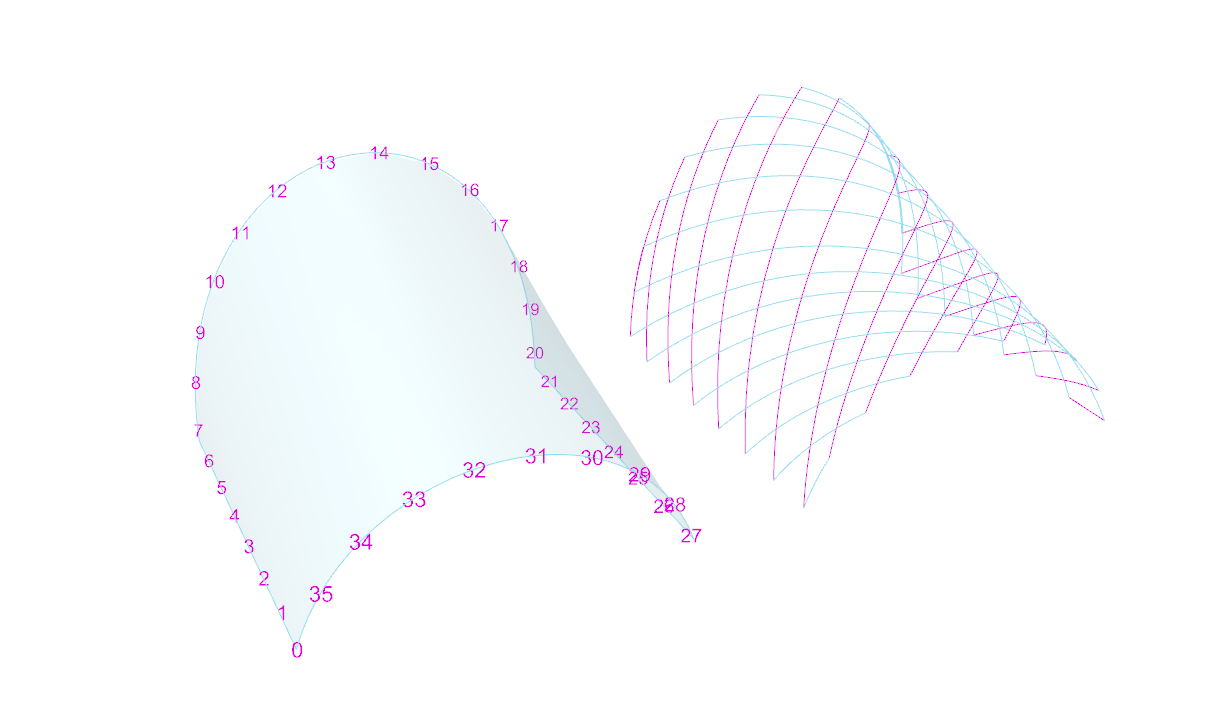
The same grid used on a conical surface starts to reveal gradual shifts in the geometry’s spacing. The curves always search for the path of least resistance in terms of bending.
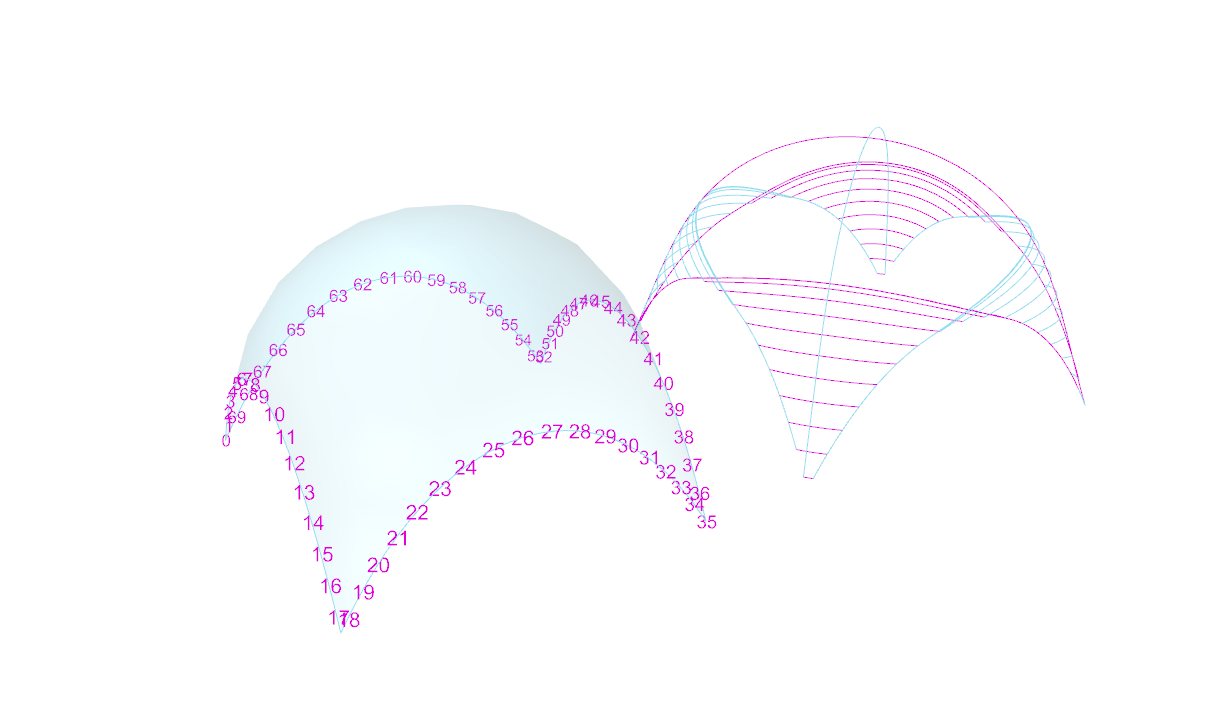
This case illustrates the nature of geodesic curves quite well. The dome was free-formed with a relatively high degree of curvature. A small change in the location of each anchor point translates to a large change in curvature between them. Each curve looks for the shortest path between each pair (without leaving the surface), but only has access to single curvature.
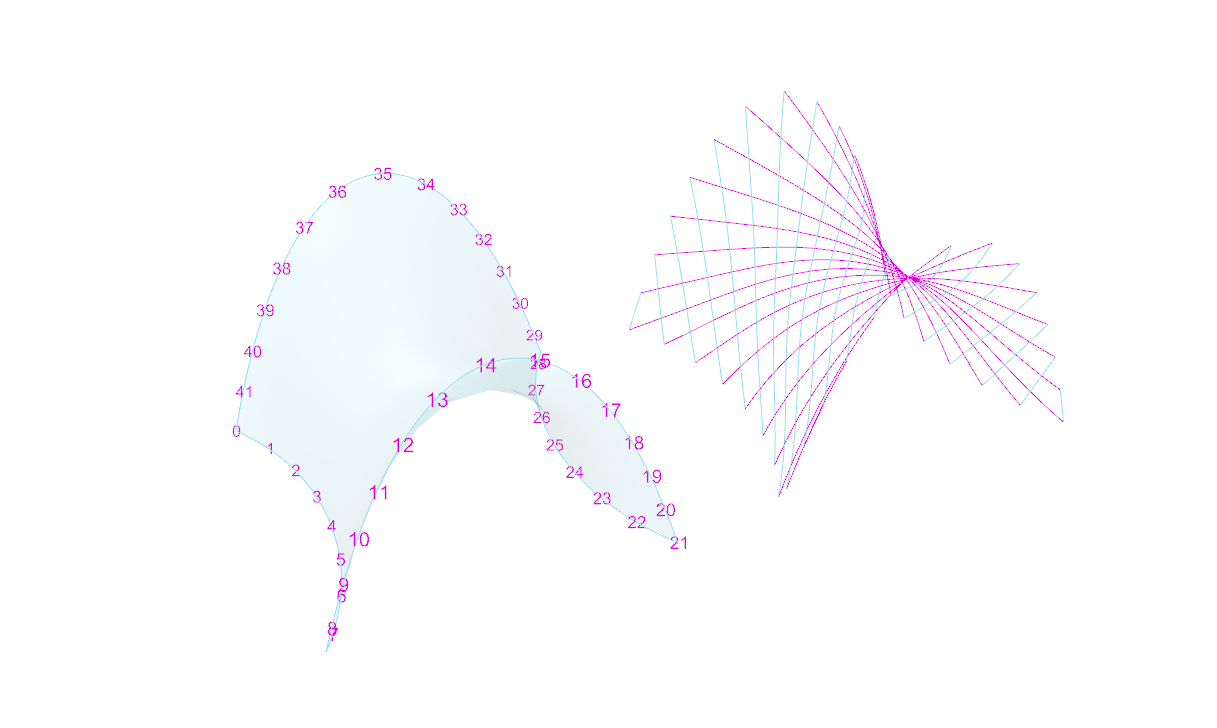
Structurally speaking, things get much more interesting with anticlastic curvature. As previously stated, each member will behave differently based on their relative curvature and orientation in relation to the surface. Depending on their location on a gridshell, plank lines can act partly in compression and partly in tension.
While geodesic curves make it far more practical to fabricate shells, they are not a strict requirement. Using non-geodesic curves just means more time, money, and effort must go into the fabrication of each component. Furthermore, there’s no reason why you can’t use alternate grid patterns. In fact, you could use any pattern under the sun – any motif your heart desires (even tessellated puppies.)
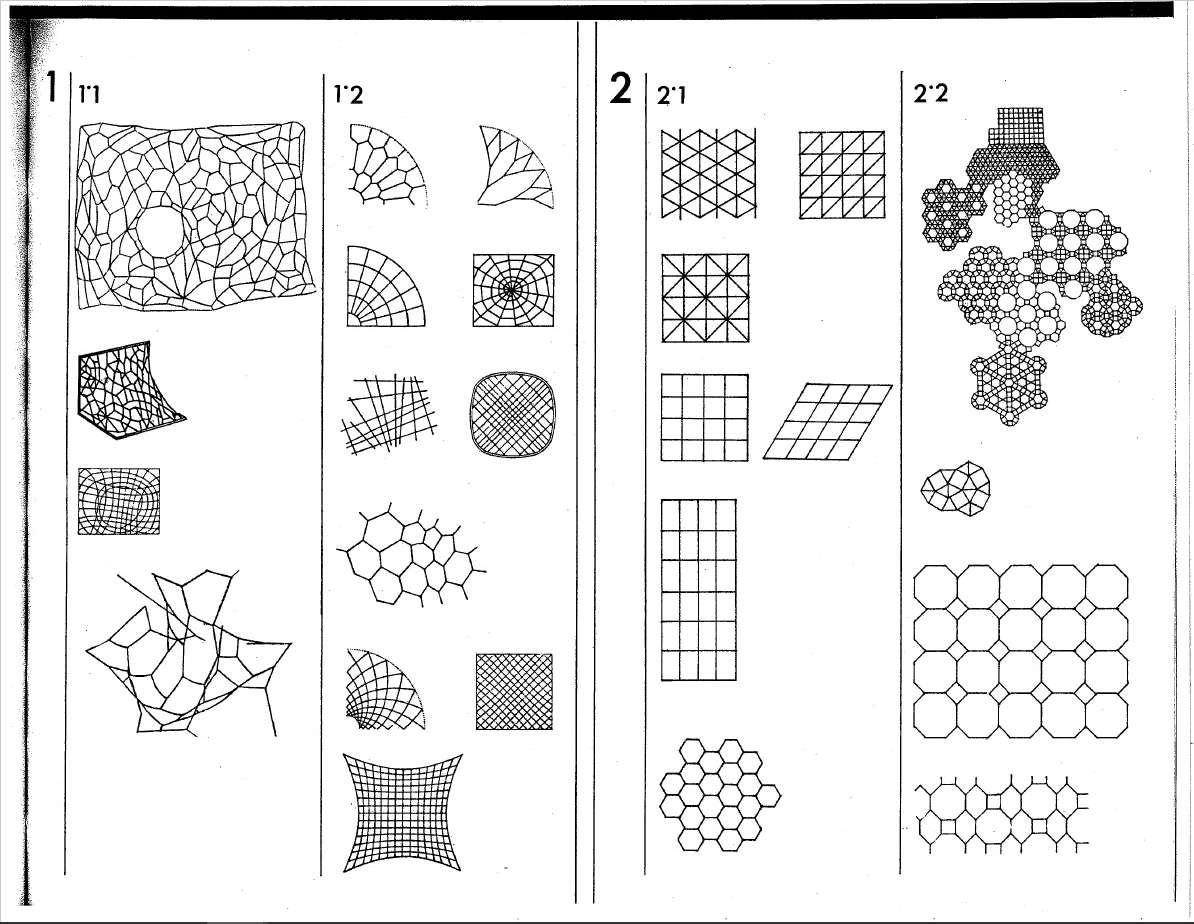
Here are just a few of the endless possible pattern. They all have their advantages and disadvantages in terms of fabrication, as well as structural potential.
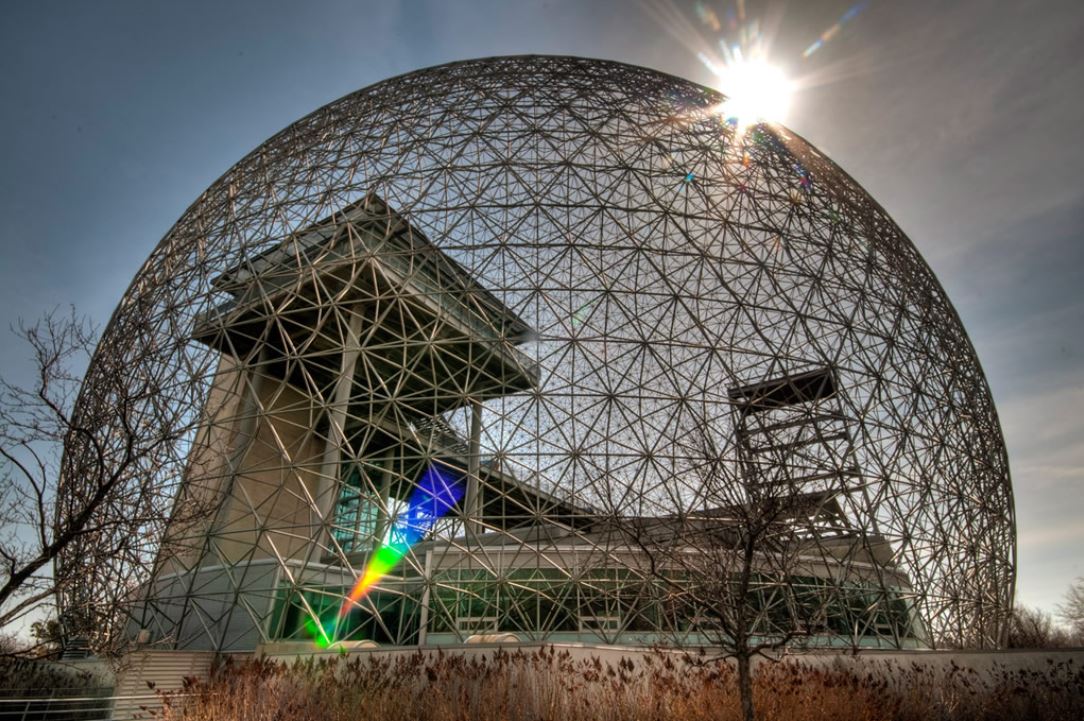
Gridshells with large amounts of triangulation, such as Buckminster Fuller’s geodesic spheres, typically perform incredibly well structurally. These structure are also highly efficient to manufacture, as their geometry is extremely repetitive.
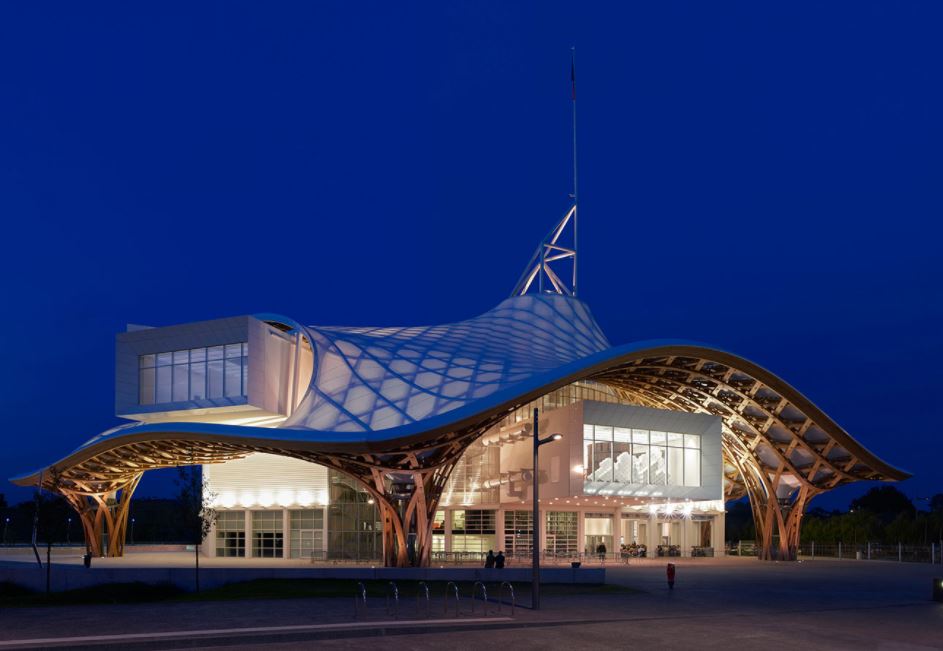
Gridshells with highly irregular geometry are far more challenging to fabricate. In this case, each and every piece had to be custom made to shape; I imagine it must have costed a lot of money, and been a logistical nightmare. Although it is an exceptionally stunning piece of architecture (and a magnificent feat of engineering.)
In our case, building these shells is simply a matter of converting the geodesic curves into planks lines.
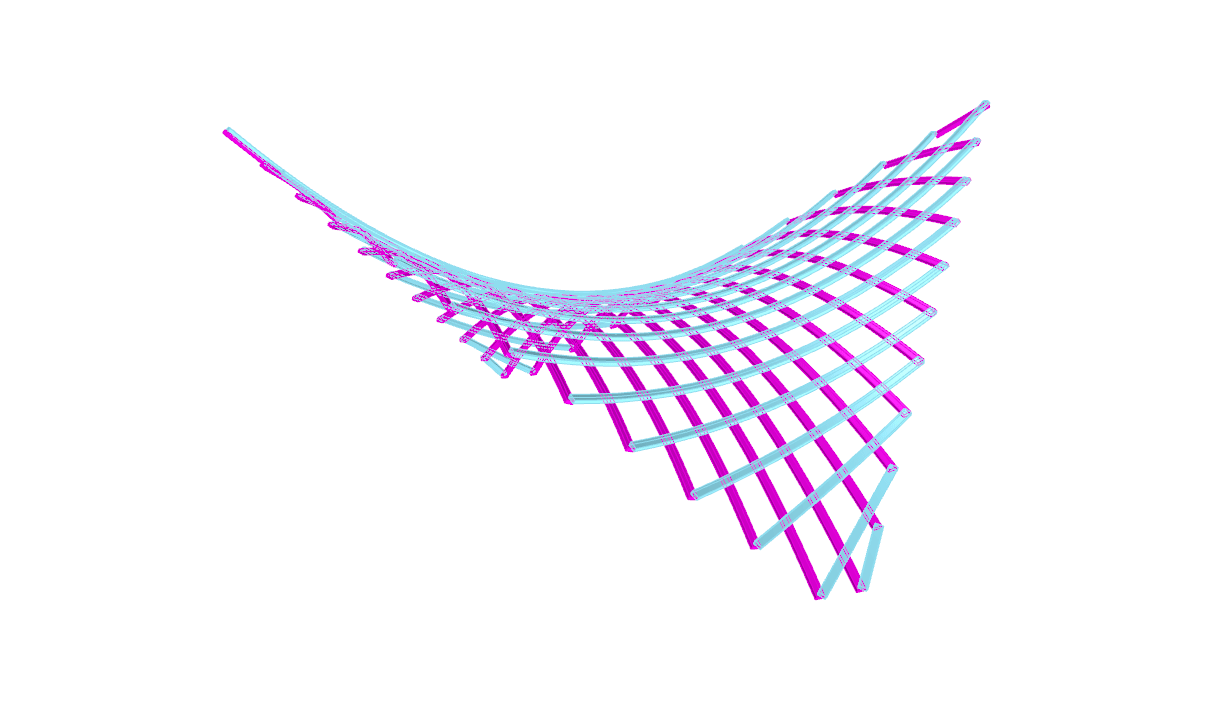
The whole point of using them in the first place is so that we can make them out of straight material that don’t necessitate double curvature. This example is rotating so the shape is easier to understand. It’s grid is also rotating to demonstrate the ease at which you can play with the geometry.
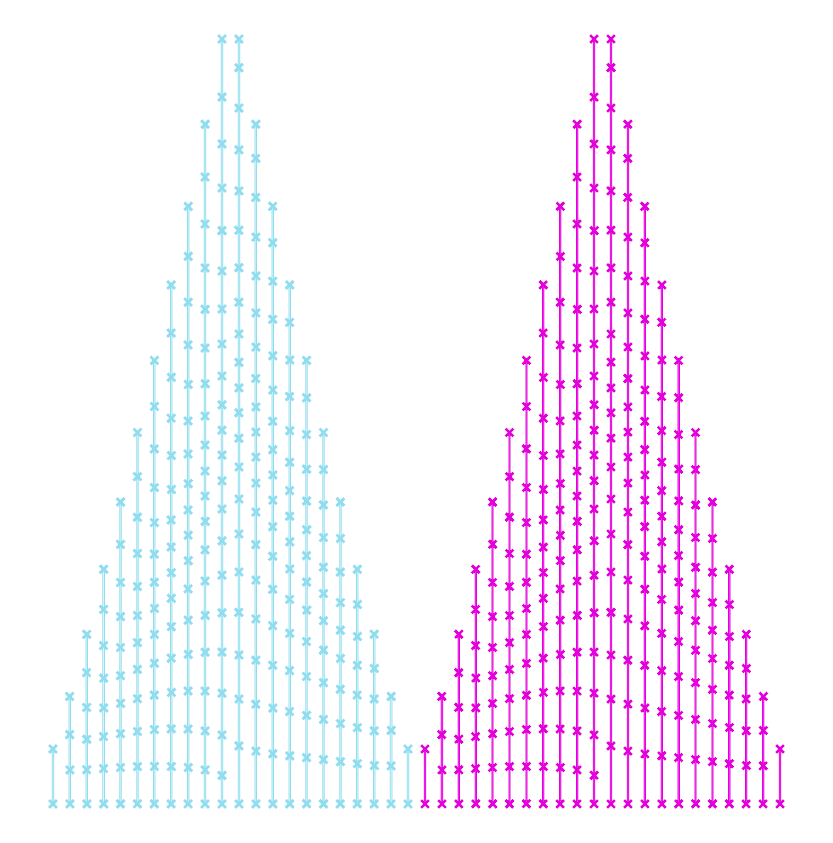
This is what you get by taking those plank lines and laying them flat. In this case both sets are the same because the shell happens to the identicall when flipped. Being able to use straight material means far less labour and waste, which translates to faster, and or cheaper, fabrication.
An especially crucial aspect of gridshells is the bracing. Without support in the form of tension ties, cable ties, ring beams, anchors etc., many of these shells can lay flat. This in and of itself is pretty interesting and does lends itself to unique construction challenges and opportunities. This isn’t always the case though, since sometimes it’s the geometry of the joints holding the shape together (like the geodesic spheres.) Sometimes the member are pre-bent (like Pompidou-Metz.) Although pre-bending the timber kinda strikes me as cheating thought.. As if it’s not a genuine, bona fide gridshell.
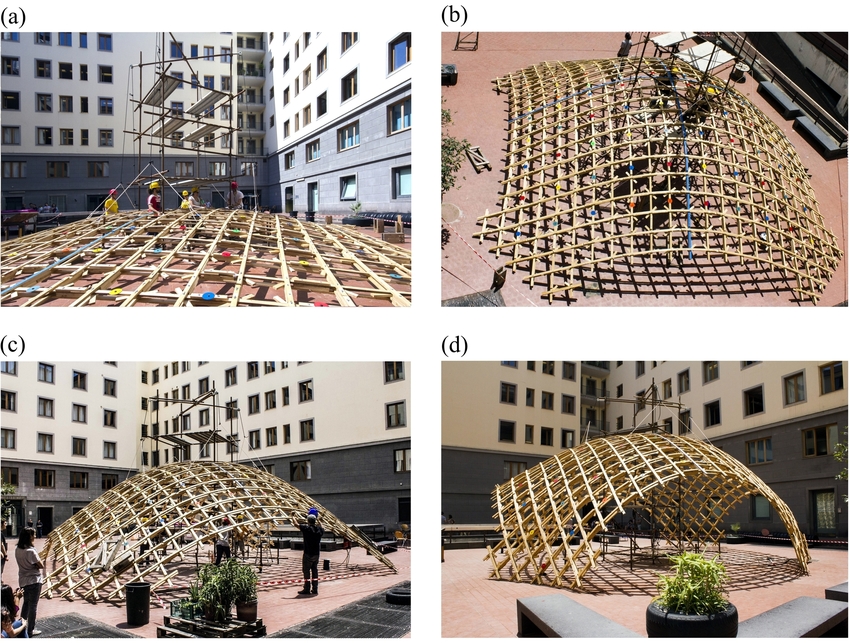
This is one of the original build method, where the gridshell is assembled flat, lifted into shape, then locked into place.
Having studied the basics makes exploring increasingly elaborate geometry more intuitive. In principal, most of the shells we’ve looked are known to perform well structurally, but there are strategies we can use to focus specifically on performance optimization.
These are surfaces that are locally area-minimizing – surfaces that have the smallest possible area for a defined boundary. They necessarily have zero mean curvature, i.e. the sum of the principal curvatures at each point is zero. Soap bubbles are a great example of this phenomenon.
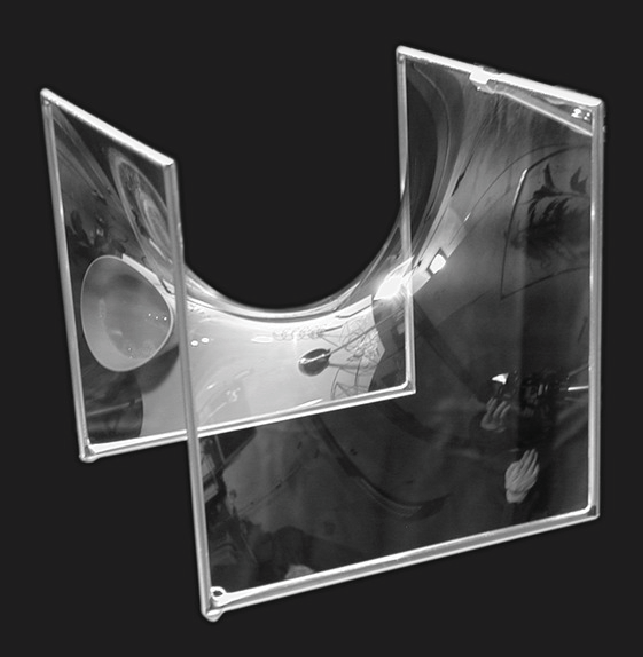
Hyperbolic Paraboloid Soap Bubble [Source: Serfio Musmeci’s “Froms With No Name” and “Anti-Polyhedrons”]Soap film inherently forms shapes with the least amount of area needed to occupy space – that minimize the amount of material needed to create an enclosure. Surface tension has physical properties that naturally relax the surface’s curvature.
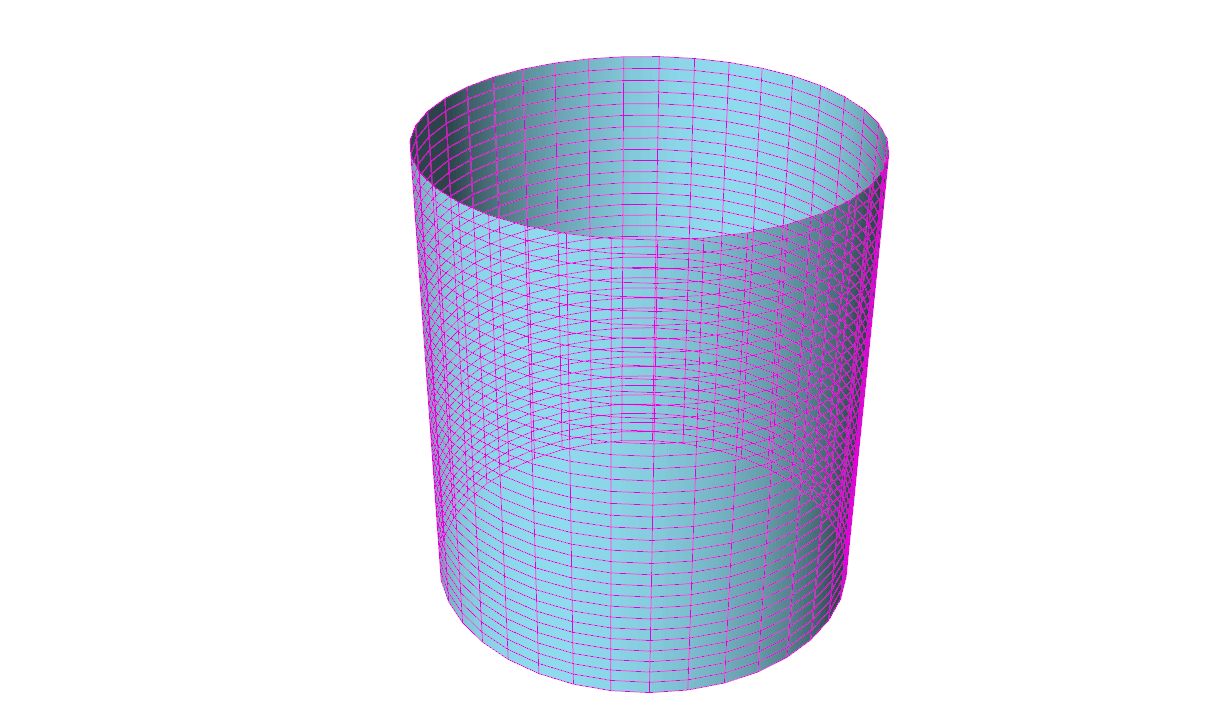
We can simulate surface tension by using a network of curves derived from a given shape. Applying varies material properties to the mesh results in a shape that can behaves like stretchy fabric or soap. Reducing the rest length of each of these curves (while keeping the edges anchored) makes them pull on all of their neighbours, resulting in a locally minimal surface.
Here are a few more examples of minimal surfaces you can generate using different frames (although I’d like stress that the possibilities are extremely infinite.) The first and last iterations may or may not count, depending on which of the many definitions of minimal surfaces you use, since they deal with pressure. You can read about it in much greater detail here: https://tinyurl.com/ya4jfqb2

Here we have one of the most popular examples of minimal surface geometry in architecture. The shapes of these domes were derived from a series of studies using clustered soap bubbles. The result is a series of enormous shells built with an impressively small amount of material.
Triply periodic minimal surfaces are also a pretty cool thing (surfaces that have a crystalline structure – that tessellate in three dimensions):
Another powerful method of form finding has been to let gravity dictate the shapes of structures. In physics and geometry, catenary (derived from the Latin word for chain) curves are found by letting a chain, rope or cable, that has been anchored at both end, hang under its own weight. They look similar to parabolic curves, but perform differently.
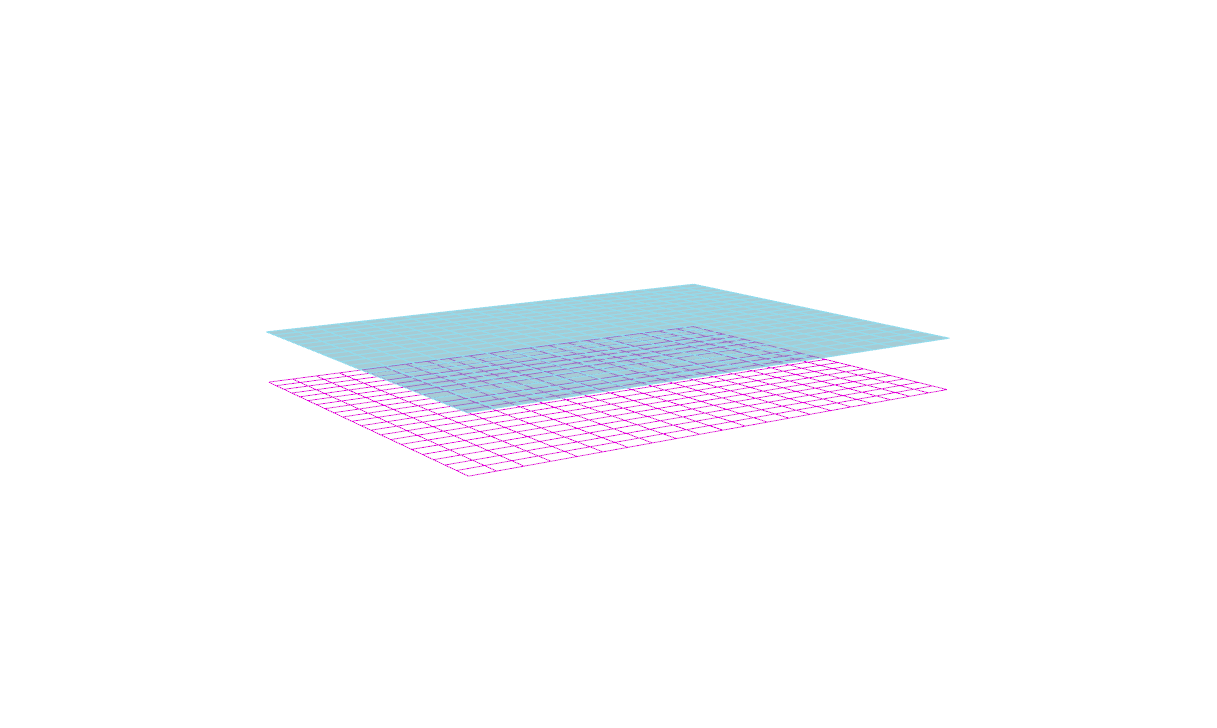
A net shown here in magenta has been anchored by the corners, then draped under simulated gravity. This creates a network of hanging curves that, when converted into a surface, and mirrored, ultimately forms a catenary shell. This geometry can be used to generate a gridshell that performs exceptionally well under compression, as long as the edges are reinforced and the corners are braced.
While I would be remiss to not mention Antoni Gaudí on the subject of catenary structure, his work doesn’t particularly fall under the category of gridshells. Instead I will proceed to gawk over some of the stunning work by Frei Otto.
Of course his work explored a great deal more than just catenary structures, but he is revered for his beautiful work on gridshells. He, along with the Institute for Lightweight Structures, have truly been pioneers on the front of theoretical structural engineering.
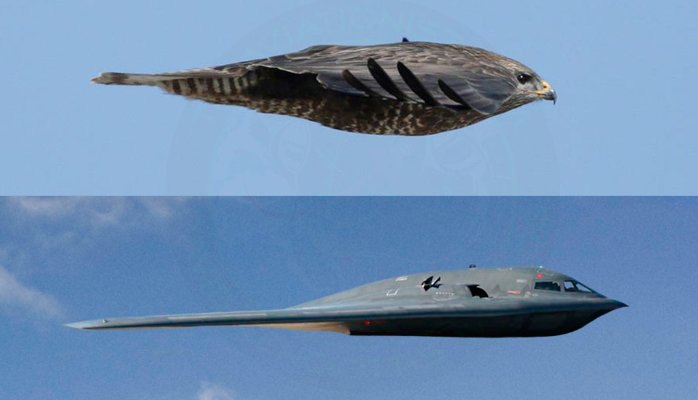
Frei Otto is a fine example of ecological literacy at its finest. A profound curiosity of the natural world greatly informed his understanding of structural technology. This was all nourished by countless inquisitive and playful investigations into the realm of physics and biology. He even wrote a series of books on the way that the morphology of bird skulls and spiderwebs could be applied to architecture called Biology and Building. His ‘IL‘ series also highlights a deep admiration of the natural world.
Of course he’s the not the only architect renown their fascination of the universe and its secrets; Buckminster Fuller and Antoni Gaudí were also strong proponents of biomimicry, although they probably didn’t use the term (nor is the term important.)
Gaudí’s studies of nature translated into his use of ruled geometrical forms such as hyperbolic paraboloids, hyperboloids, helicoids etc. He suggested that there is no better structure than the trunk of a tree, or a human skeleton. Forms in biology tend to be both exceedingly practical and exceptionally beautiful, and Gaudí spent much of his life discovering how to adapt the language of nature to the structural forms of architecture.
Fractals were also an undisputed recurring theme in his work. This is especially apparent in his most renown piece of work, the Sagrada Familia. The varying complexity of geometry, as well as the particular richness of detail, at different scales is a property uniquely shared with fractal nature.
Antoni Gaudí and his legacy are unquestionably one of a kind, but I don’t think this is a coincidence. I believe the reality is that it is exceptionally difficult to peruse biomimicry, and especially fractal geometry, in a meaningful way in relation to architecture. For this reason there is an abundance of superficial appropriation of organic, and mathematical, structures without a fundamental understanding of their function. At its very worst, an architect’s approach comes down to: ‘I’ll say I got the structure from an animal. Everyone will buy one because of the romance of it.”
That being said, modern day engineers and architects continue to push this envelope, granted with varying levels of success. Although I believe that there is a certain level of inevitability when it comes to how architecture is influenced by natural forms. It has been said that, the more efficient structures and systems become, the more they resemble ones found in nature.
Euclid, the father of geometry, believed that nature itself was the physical manifestation of mathematical law. While this may seems like quite a striking statement, what is significant about it is the relationship between mathematics and the natural world. I like to think that this statement speaks less about the nature of the world and more about the nature of mathematics – that math is our way of expressing how the universe operates, or at least our attempt to do so. After all, Carl Sagan famously suggested that, in the event of extra terrestrial contact, we might use various universal principles and facts of mathematics and science to communicate.

INSTALLATION SUBMISSION TO BURNING MAN 2016 – ‘Entwine’
Entwine is a timber frame structure which has been developed through rigorous physical and digital testing to ensure a safe climbing frame for all to enjoy. When exploring Entwine, the vast expanse of the playa is framed through beautiful intertwining curved plywood beams. Burners can view the event from glorious vantage points nestled amidst multiple communal spaces that encourage interaction and play.
The structure predominantly consists of strips of curved plywood which have been connected together using pioneering construction techniques, specifically the utilisation of conflicting forces, similar to those apparent in ‘Tensegrital’ design. Drawing inspiration from Leonardo Da Vinci and his various experimentations with physical form, ‘Entwine’ is a marvel of geometry. The piece is formed from an arrangement of 19 octahedral components, each consisting of six beams, which are paired and positioned upon one of three axis. These three elements represent the unity of man, nature and the universe that surrounds us.



Each modular component is tessellated to form an octahedral space frame structure. The rigidity resulting from this tessellation is in direct contrast to the curving structural beams which exude an organic aesthetic. As Burners view Entwine from different aspects, a remarkable array of different patterns and forms are revealed, many bearing resemblance to sacred geometry, specifically the Flower of Life, which was a significant study within Leonardo Da Vinci’s work.

Entwine is unorthodox in its composition, and this is a contributing factor to what makes it so unique: Each module is constructed through tensioning layers of ¼ inch thick plywood, which are then mechanically fixed together when a desired radius has been reached. By laminating the plywood in this manner, each component retains its curvature but remains in compression. These conflicting forces are integral to the design of Entwine: Each octahedral module is constructed from these compressed plywood elements, and are held together with tensioning ropes creating a structure of isolated components in compression within a net of continuous tension.
 The form of the structure is based on the octahedron, which is a Platonic solid composed of eight equilateral triangles; four of which meet at each vertex. One of the eight triangles acts as a base for the structure. This results in one edge creating a small cantilever, whilst the counter edge can be anchored to the ground. As previously studied by Buckminster Fuller, the geometry of an octahedron is particularly good at forming space frames with a strong cantilevers.
The form of the structure is based on the octahedron, which is a Platonic solid composed of eight equilateral triangles; four of which meet at each vertex. One of the eight triangles acts as a base for the structure. This results in one edge creating a small cantilever, whilst the counter edge can be anchored to the ground. As previously studied by Buckminster Fuller, the geometry of an octahedron is particularly good at forming space frames with a strong cantilevers.


The participatory aspect of the installation voids the role of the ‘spectator’ and creates more active engagement. In many of Leonardo Da Vinci’s paintings, his subjects are framed by surreal, dreamlike landscapes. This is reflected within Entwine: As Burners become part of the installation, they are framed by the awe inspiring backdrop of Black Rock Desert: In many ways Entwine becomes the artist, the playa the canvas, and Burners the subjects.
“the artist is not a special sort of person, but every person is a special sort of artist.”
This is not only true in the sense of physical involvement but during the construction the ‘spectator’ becomes involved in making strategic decisions in the realisation of the work of art. The development, design and construction of the project embodies the principles of self-reliance and self-expression, whilst a proposal that is safe, interactive and beautiful will be gifted to the community at Burning Man.
Entwine’s curving form will be illuminated using LED spot lights to enhance the organic patterning existent within the structure. This allows the full form of the structure to be fully visible.
Tensegrity structure or also known as tensional integrity, a portmanteau term that was coined by Buckminster Fuller in the 1960s. It is a structural principle which is based on the use of detached components in compression inside a net of continuous tension.It is also known as “floating compression”, a term that was promoted by Kenneth Snelson. Each compressed members such as struts or bars do not touch among another and the prestressed tensioned members , tendons or cables for example, define the system spatially. Snelson defines tensegrity as a closed structural system composed of a set of three or more elongate compression struts within a network of tension tendons, the combined parts mutually supportive in such a way that the struts do not touch one another, but press outwardly against nodal points in the tension network to form a firm, triangulated, prestressed, tension and compression unit. Triangulated network are stronger and even more firm, if compared to non-triangulated network.
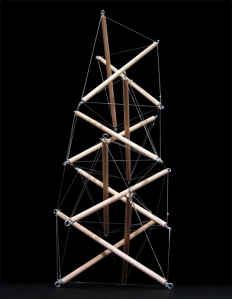

Biotensegrity
Biotensegrity, is a term coined by Dr. Stephen Levin, is the application of tensegrity principles to biologic structures.Harvard physicians and scientist Donald Ingber has developed a theory of tensegrity in molecular biology to explain cellular structure.The shape of cells are all can be mathematically modelled if a tensegrity model is used for cell’s cytoskeleton. Cytoskeleton is a network of fivers composed of proteins contained within a cell’s cytoplasm, which is dynamic structure, parts of which are constantly destroyed, renewed or newly constructed.
The study of tensegrity structure started through geometric remodeling the tensegrity model using digital softwares, to understand the deployability of the system . The basic form of tensegrity is being explored through addition of struts in the cell modules . The basic cell module is then are combined according to geometry tessellation . They were applied on regular surface and also irregular surface , while maintaining the structural frequency and mesh tension .
By using basic cell module of 3 struts, the tensional components were explored both using cables and fabric . The fabric helps in creating enclosures and more aesthetically pleasing in installation. It is still in the beginning of the design by studying the behavior of the system, with the goal to expand the possibilities of design in the future , either for Burning Man or Buro Happold.
For the next project, the possibility of the tensegrity structures will be explored more and the design will be highlighted on the playful intervention of tensegrity structure and the advantages of this super lightweight system for both proposal for Burning Man and Buro Happold .
Philosophical Statement:
‘Timber-Wave’; a plywood instillation emerging and crashing on to the desolate Black Rock Desert. This breaking wave a remnant of the retreating Quinn River, draws on imagery of both waves and dunes provoking thoughts of the original Burning Man Beach Parties and surfing counter culture. Simultaneously the design evokes concepts of the Silk Road as a mirage of a giant wave appearing from across the playa to be discover by wondering burners.
The design of the Timber Wave was driven by creating an interactive environment. In daytime, people are encourages to climb and search between the interwoven plywood structure. Open sun soaked communal areas create areas for group contemplation. Solitary areas for single travelers have also been designed as places of refuge from the intense sun, wind and dust storms hoping to encourage serendipity. At night the wave truly come alive as a monument to the sea. Bathed in varying blue tones of color the spectacular structure is a mysterious beacon within the dark playa.
Physical Statement:
‘Timber-Wave’ structure consists of 3 layers of 12 intersecting plywood ribbons. Each ribbon consists of a varying number of water bent plywood components con-caving and con-vexing together forming a rigid series of tensioned and compressed sections. The result is a homogeneous structure creating a beautiful ergonomically sized spaces. Each ribbon a series of circular penetrations in the form of an abstracted water pattern. Creating foot and hand holes for climbing as well as allowing dramatic shadows to be cast throughout the structure and across the playa. At night the penetrations allow the lighting of the instillation to spill across the playa and between the layers of the structure.
1:20 Scale Model
Mother nature protects the most vulnerable, the weak, the young, the very seeds of growth. At the heart of nature is the dispersal of its seeds. Burrs which catch a lift, dandelion seeds that ride on the wind and those that are catapulted, but perhaps the most enterprising of all are the seeds that are distributed far and wide…
The Burning Seed has arrived in the desert having fallen far from its original host. Inspired by the intricate geometry of the Flower of Life, the impetus behind the design is rooted in nature. The structure’s spiky exterior belies its beauty within – a space of refuge, protection from the prevailing winds and shelter from the intensity of the sun’s rays. The design of The Burning Seed has been driven by its interactivity. In daytime, people climb between the structure’s wooden thorns and look through to its centre at those who have managed to penetrate its hostile shell. Inside they bask in the smooth, spherical interior, interacting with the harmony of the structure and one another. At night the spectacle is truly realized as a flurry of fibre optic lights protrude from the thorns, adorning the structure in a wash of blue, purple and green light.
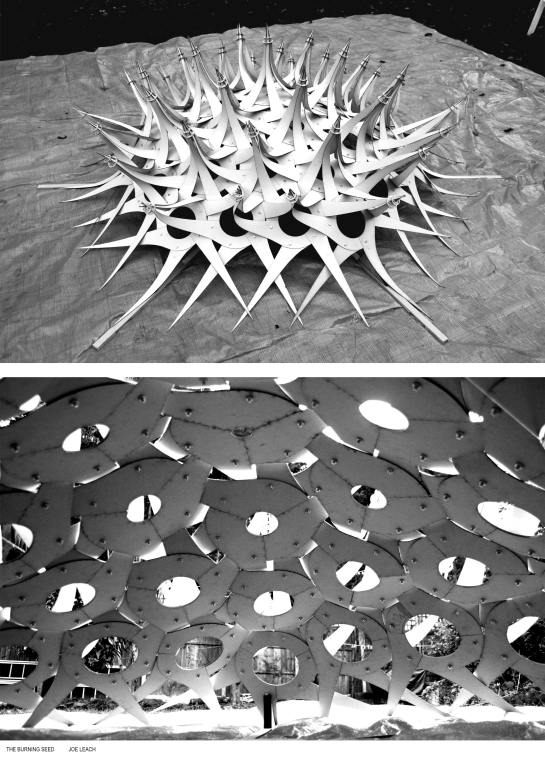
The structure consists of 37 star shaped plywood components which interlace to form the lightweight dome. The legs of the components are bent outwards from the centre and join to create the thorns of its exterior. The structure is reciprocal, with each component supporting the neighbouring pieces, there is no requirement for a central support. This results in a homogeneous internal space with a beauty derived from its inherent highly symmetrical patterns. The components have differently sized circular holes though their centres. This creates a porous structure and a patterned light effect to be cast on the desert floor. The size of these openings reflects the geometry of the ‘Fruit of Life’ symbol, a derivative of the Flower of Life. It is said to be the blueprint of the universe, containing the basis for the design of every atom, molecular structure, life form, and everything in existence.
FLAME SYSTEM – OPTIONAL ADDITION:
An optional flame system for The Burning Seed allows fire to intermittently burst from the tips of the copper from six spikes, illuminating the Burning Seed in orange glow. This feature can be incorporated into the design following discussion with the Burning Man Festival Organisers.
Three great BBC documentary films by Adam Curtis which help to understand our unit’s agenda: From Ayn Rand and Buckminster Fuller and the birth of the Californian Ideology, Ecology, Eco-Systems, Systems Theory and Cybernetics to George Price, Richard Dawkins and the Selfish Gene, see how the concept of “network” and “nature” has evolved as an ideology through modern times.

All Watched Over by Machines of Loving Grace is a series of film about how humans have been colonized by the machines they have built. Although we don’t realize it, the way we see everything in the world today is through the eyes of the computers. It claims that computers have failed to liberate us and instead havedistorted and simplified our view of the world around us.
1. Love and Power. This is the story of the dream that rose up in the 1990s that computers could create a new kind of stable world. They would bring about a new kind global capitalism free of all risk and without the boom and bust of the past. They would also abolish political power and create a new kind of democracy through the Internet where millions of individuals would be connected as nodes in cybernetic systems – without hierarchy.
2. The Use and Abuse of Vegetational Concepts. This is the story of how our modern scientific idea of nature, the self-regulating ecosystem, is actually a machine fantasy. It has little to do with the real complexity of nature. It is based on cybernetic ideas that were projected on to nature in the 1950s by ambitious scientists. A static machine theory of order that sees humans, and everything else on the planet, as components – cogs – in a system.
3. The Monkey in the Machine and the Machine in the Monkey. This episode looks at why we humans find this machine vision so beguiling. The film argues it is because all political dreams of changing the world for the better seem to have failed – so we have retreated into machine-fantasies that say we have no control over our actions because they excuse our failure.
Adam Curtis is a documentary film maker, whose work includes The Power of Nightmares,The Century of the Self, The Mayfair Set, Pandora’s Box, The Trap and The Living Dead.
TETRA is an installation that exploits the potential of mass participation to create a form that emerges from the interactions of hundreds of people with the construction system over a number of days.
Inspired by the work of R. Buckminster Fuller into space-packing polyhedra, it explores the unique three dimensional geometrical properties of the regular tetrahedron and related ‘tetrahelices’ [also known Boerdijk–Coxeter Helices]. Their geometries provide an invisible framework for the participants to work within. The modular tetrahedral construction system will be used by the participants to create forms that automatically diverge from one another.
These in turn provide spaces separated from other participants for individuals to pause and reflect on the location and nature of their surroundings. TETRA’s position out on the edge of Black Rock City means that once the structure starts to take shape, participants will be able to climb to positions that afford views across the city. Just as Burning Man asks participants to take a step back from the consumer capitalism, so TETRA allows participants to step back and view Black Rock City as a whole
TETRA is a modular kit of parts that are assembled by participants into a structure that changes form over the course of the festival. There are 160 modules, each one a tetrahedron made from four equilateral triangle shaped pieces of CNC cut exterior plywood. Each triangular face has a hole cut from its centre which, as well as decreasing the overall weight of the module, allows the modules to become rungs in a structure that can be climbed up, on, in and through.
The ply edges of the four plywood triangles are bound together with rope to ensure a joint that can transmit loads in tension from one sheet of ply to the adjacent two. There are pre-drilled re-enforced holes near each vertex to allow for adjacent modules to be bolted together with bolts and wing-nuts by participants.
Each module is designed for one person to carry while climbing sections of the structure already built. The participants are able to climb any of the structure that is already built, and bolt their new module onto the existing structure. Once built, participants are able to climb up, select a module to remove and move to another place. This means that the overall form is not set by the designer, but emerges from the collective desires of a large group of participants.
Because of the intrinsic geometry of tetrahedra and tetrahelices, the form will always contain diverging branches with inhabitable spaces within them.
This animation shows a model made from modular magnetic tetrahedra. Each tetrahedron has a side length of 50mm, and contains four spherical neodymium magnets.
The tetrahedra build up according to rules that stem from their dihedral angle [angle between two faces]. The dihedral angle of a tetrahedron given by θ=arccos(1/3) [approx 70.5288°]. This means that five tetrahedra placed face to face around a single axis fall approximately 7.2° short of a full 360°. Because of this, the tetrahedra do not fill space, and instead form sections of helical structures called Boerdijk–Coxeter Helices [Named ‘Tetrahelices’ by Buckminster Fuller].
The magnets in the tetrahedra ensure that when placed by hand, they lock together face to face to form structures that completely follow these rules. When pushed just within range of the magnets of other tetrahedra, they exhibit self organising properties, but due to the power of the magnets, occasionally stick edge to edge or vertex to vertex instead of face to face.
How much does your building weigh?, asked Buckminster Fuller. Now again the curator of the Biennale Terence Riley asks the same question to all six international teams invited to the project “Ultra Lightweight Village” for the 2011 Shenzhen & Hong Kong biennale of urbanism\architecture.
Clavel Arcquitectos’ installation is composed by three circles of waterproof light fabric of 7.8, 6.4 and 5.4 meter of diameter spin around their axis at only 1.5 turns per second. In the biggest one we can reach to cantilever of nearly 4 meters with an only 2 mm roof thickness. It is interesting to check how similar is the movement with the animal aquatic one. Thanks to the rotation the gravity apparently disappears and only aerodynamical forces shape the fabric. The soft waves produced on the surface create a smooth breeze that improves the thermical conditions behind during the hot and sunny days.
The pavilion creates a specific place for children that can experiment with the centrifugal forces, generate electricity to open the structures and activate the lighting. The faster the children chairs rotate the brighter the structure will be.


Above: Centrifugal Pavilion by Clavel Arquitectos
Click on the following link for the full video: